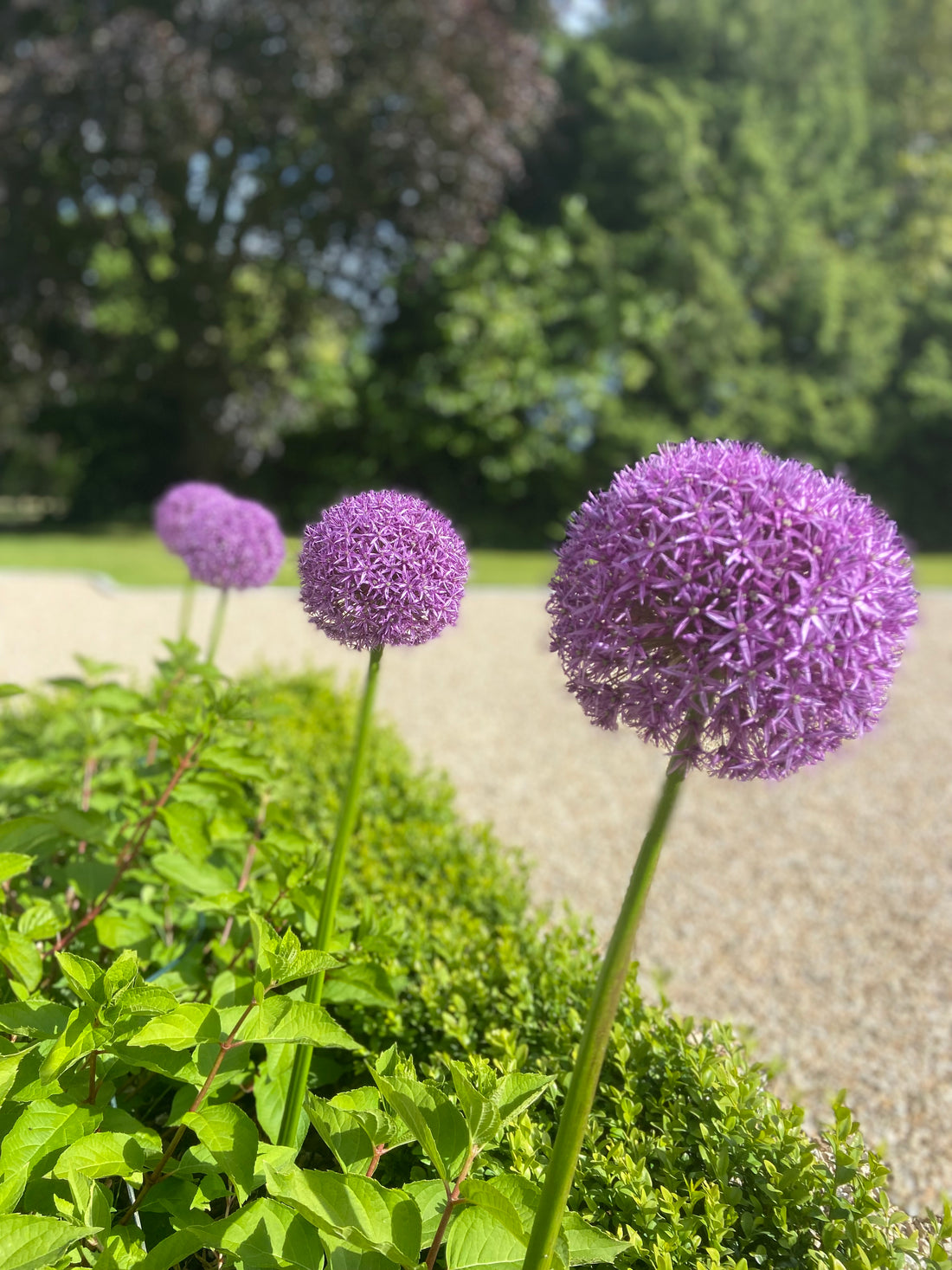
The Wonderful World of Alliums
When I think about my garden in early summer, one plant always comes to mind—alliums. These stunning globe-shaped flowers are more than just a burst of purple in my flowerbeds; they’re a bridge between spring and summer, filling the gap before my hydrangeas take centre stage. And if I had to pick two absolute favourites, it would be the show-stopping Allium ‘Gladiator’ and the majestic Allium ‘Globemaster.’ These two varieties are the crowning jewels of my garden and a must-have for any allium lover.

Varieties of Alliums
Alliums, members of the onion family, come in an impressive array of shapes and sizes, but none are quite as impressive as the ‘Gladiator’ and ‘Globemaster.’
- Allium ‘Gladiator’: Tall and commanding, this variety produces enormous blooms that can reach up to 6 inches across on stems as tall as 4 feet. The light purple flowers have a soft, ethereal quality, and their height makes them perfect for the back of a border. They’re also incredibly long-lasting—both in the garden and as a cut flower.
- Allium ‘Globemaster’: If you’re looking for drama, look no further. ‘Globemaster’ is known for its massive, densely packed flower heads, which can be up to 10 inches in diameter. They’re a rich purple that fades beautifully as they mature. With their sturdy stems and impressive size, they’re a true statement plant that demands attention.

Of course, there are many other fantastic varieties to explore:
- Allium giganteum: Another tall variety with striking purple spheres.
- Allium ‘Purple Sensation’: A versatile, smaller allium that works beautifully in mixed borders.
- Allium christophii (Star of Persia): Perfect for adding an airy, whimsical touch to the garden.
But for sheer size and impact, ‘Gladiator’ and ‘Globemaster’ will always have my heart.
When to Plant Alliums
Alliums are planted as bulbs in the autumn, typically around late October, before the first frost. They prefer well-drained soil and a sunny spot. For my ‘Gladiator’ and ‘Globemaster,’ I like to plant them about 8 inches apart and at a depth of 4-6 inches. Don’t be shy about giving them a prime spot—they’ll reward you with their grandeur come summer.
When They Bloom
Alliums bloom from late spring to early summer, filling that critical gap between the end of the spring bulbs and the arrival of summer perennials. ‘Gladiator’ and ‘Globemaster’ are some of the earlier bloomers in the allium family, with their flowers often lasting weeks. This extended bloom time makes them perfect companions for my hydrangeas, which are still gearing up for their mid-summer show.
Why Alliums Are Good for Biodiversity
Alliums are a gift to the garden’s ecosystem. Their nectar-rich blooms attract bees, butterflies, and other pollinators, making them an excellent choice for supporting biodiversity. I often find bumblebees happily buzzing around my ‘Globemaster’ blooms, their soft hum adding a gentle soundtrack to early summer mornings.
Another benefit? Alliums are deer- and rabbit-resistant, which means I can enjoy them without worrying about unwanted visitors nibbling them away.
How I Pair Alliums in My Garden
‘Gladiator’ and ‘Globemaster’ are the perfect partners for my hydrangeas. Their tall, striking blooms rise above the leafy hydrangea bushes, creating a layered effect that looks intentional and elegant. The deep purple hues of these alliums also contrast beautifully with the lush green foliage of hydrangeas.
While hydrangeas are my go-to companion, these alliums also pair beautifully with peonies, irises, or ornamental grasses. For a more whimsical look, I like to add low-growing perennials like nepeta or creeping thyme at their base, creating a tapestry of textures and colours.

A Few Tips for Success
- Soil: Ensure well-drained soil to prevent the bulbs from rotting. Adding compost can improve drainage if needed.
- Watering: Alliums are drought-tolerant once established, but make sure the bulbs have enough moisture while they’re actively growing.
- Deadheading: Once the flowers fade, leave the seed heads. Not only are they architectural and interesting, but they’ll also continue to attract pollinators.
Why You’ll Love Alliums
If you’re looking to add bold colour, unique structure, and ecological value to your garden, alliums are a perfect choice. Whether you’re captivated by the commanding height of ‘Gladiator’ or the unrivalled size of ‘Globemaster,’ these plants will bring drama and delight to your flowerbeds.
This autumn, make space for a few allium bulbs in your garden. By early summer next year, you’ll have a stunning display that not only bridges the seasons but also supports the wildlife that calls your garden home. And if you’re like me, you’ll quickly fall in love with the magic of these summer jewels.
|
ReplyForward
Add reaction
|
